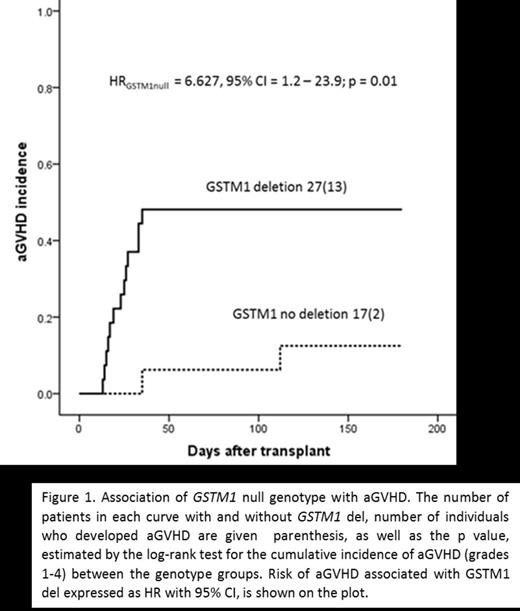Abstract
The only curative therapy for thalassemia remains the replacement of the defective erythropoiesis by allogeneic hematopoietic stem cell transplantation (HSCT). Although largely successful, HSCT can have serious adverse effects such as; veno-occlusive disease (VOD), graft failure and graft versus host disease (GVHD) associated mainly with the conditioning regimen. Most commonly used conditioning regimens in children comprise the alkylating agent busulfan (BU). Interindividual differences in Bu pharmacokinetics (PK) have been observed and may be an important cause of resistance to treatment and toxicity. It has been hypothesized that some of this variability in treatment might be predicted by genetic variants of enzymes involved in the metabolism of BU. Identifying pharmacogenetic determinants of BU may allow for prospective identification of patients with suboptimal drug responses allowing for complementation of traditional treatment protocols by genotype-based BU dose adjustment. Since BU is mainly metabolized by glutathione S-transferase (GST), we studied the relationship between functional variants within GSTA1, GSTM1 and first dose pharmacokinetics (PK) and outcomes of intravenous (IV) busulfan (Bu).
The study was performed on 44 thalassemia (thalassemia major = 35 and thalassemia intermediate = 9) pediatric patients (median age = 8, Female = 47.7%) of Middle Eastern origin, who underwent allogeneic HSCT with IV BU as part of a myeloablative-conditioning regimen. According to the standard, 5 different IV Bu doses were given based on weight: 1.0mg/kg for <9 kg, 1.2 mg/kg for 9-16 kg, 1.1 mg/kg for 16-23 kg, 0.95 mg/kg for 23-34 kg, and 0.8 mg/kg for >34 kg. Bu was administered as a 2-hour IV infusion every 6 hours for a total of 16 doses from day -9 to day -6. Bu levels following the first Bu dose were measured using an established analytical method and the PK parameters were estimated using non-compartmental analysis. Bu dose levels were adjusted at dose 4 to achieve Bu Css of 600-900 ng/mL. Genomic DNA collected prior to myeloablation was used for genotyping GSTM1 del by gel electrophoresis and GSTA1promoter variants (-69C>T, -513T>C, -631T>G and -1142) by allele-specific oligonucleotide hybridization. Statistical analysis was performed by using Linear regression to test gene-dosage effect and to assess the effect on genotype on (maximum concentration (Cmax), area under the curve (AUC), Css and Clearance (CL) in a univariate model. The cumulative incidence of aGVHD in relation to GST genotypes was estimated by one-survival curves using Kaplan-Meier analysis and log-rank test. Univariate Cox regression analysis was used to estimate hazard ratio (HR) with 95% confidence interval (CI).
Neutrophil, platelet recoveries, grade 1-4 acute GVHD, grade 2-4 acute GVHD and VOD incidences were 93.2%, 88.6%, 34.1%, 11.4% and 2% respectively. Overall survival rate was 90.9%, events free survival was 84%, while 13.6% of patients had primary and secondary graft failure. Gene-dosage effect between GSTA1 T-69 and G-1142 alleles (defining haplotypes *B and *B1, respectively) and higher Bu exposure (higher Bu levels, p≤ 0.001 and lower clearance, p=0.001) was seen. An association was also seen with GSTM1, where patients with GSTM1 null genotype had a higher occurrence of GVHD grade 1-4 (p=0.01), see Figure 1.
A strong association between GSTA1*B and BU PK was observed in accordance with the functionality of this variant and our previous analysis in a different patient cohort. We were unable to test whether this variant increases BU related-VOD due to the low VOD cases. GSTA1 and GSTM1 variants could potentially open the possibility to tailor first Bu dose according to patient genetics.
No relevant conflicts of interest to declare.
Author notes
Asterisk with author names denotes non-ASH members.


